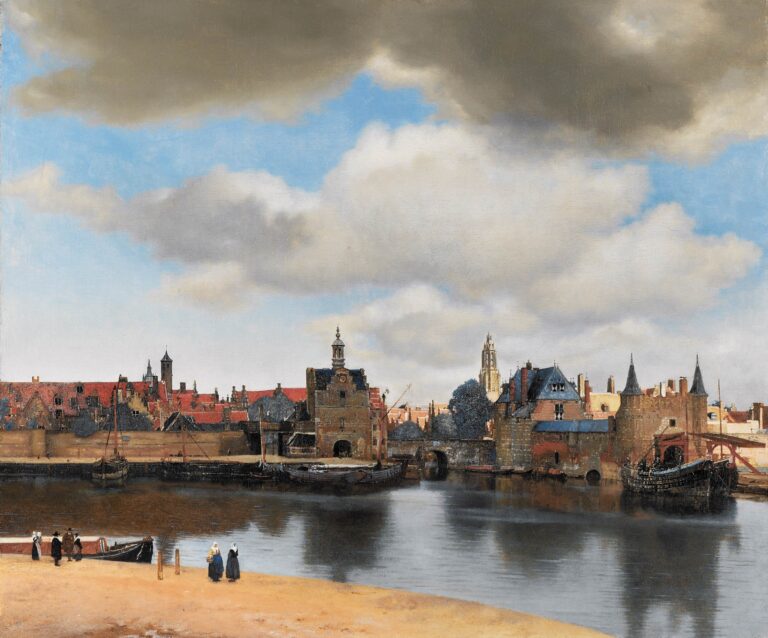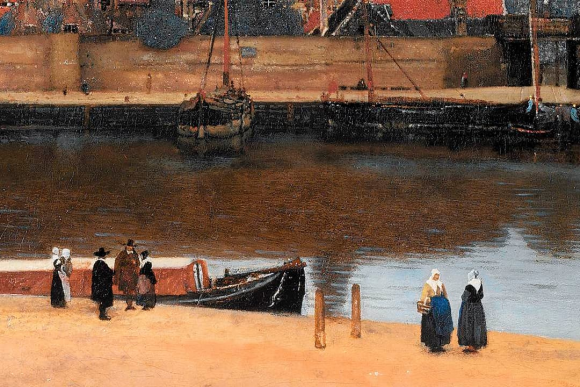Delft and Vermeer
Johannes Vermeer is a canonical 17th-century Dutch painter born in 1632 in Delft. How Vermeer was trained as an artist remains to be known. He may have studied under a master. Nonetheless, the pictorial approach he developed by capturing light and its magical atmospheres with a gradation of thin and thick strokes and thin layers of oil paint was characteristic in art history—besides his meticulously selected color palette and his compositions painstakingly executed down to the smallest detail.
The city of Delft, Vermeer’s hometown, was a crucial place his work would frequently return to. Located in the province of South Holland, the economic and cultural center, its history and daily life inspired art with its diverse subjects to depict. In the 17th century, these included but were not limited to canals, red brick buildings, and elements part and parcel of its urban landscapes.
View of Delft
The work is a distinctively detailed rendition of the city and its landscape. Vermeer excelled in capturing the essence of Delft through a meticulous composition full of architectural and natural details. The red-brick houses near the harbor complement the reflection of towers and walls in the water and a convincing, clouded sky. Although an idealized representation, the Oude Kerk and the Nieuwe Kerk featured in the painting are still standing today.
Vermeer’s technical skill is evident throughout the work, notably in the rendering of light. A bright foreground stands out from some half-light or darker spaces and the yellow in the background. Such a play of light and shadow creates the effect of depth, which is strengthened by a layering of yellow, red, and ocher for the buildings and the shore, together with the blue, grey, and silver of the roofs, sky, and water. Vermeer clearly put a lot of effort into pigments. The work features a range of materials: from calcite, umber, lead white, and yellow ocher to madder lake and ultramarine blue.
When applying color, Vermeer varied the shape of his brushstrokes and the thickness of each layer of paint. Thus, he could define in great detail the elements of the urban landscape, such as the reflections of light on water. The brushstrokes also add color and texture, say, when depicting the surfaces of buildings. Texture is crucial to convey realism. Here it reveals a variety of senses: the roughness of orange tile and blue slate roofs, the toughness of brick-and-mortar walls and bridges, the hardness of the stone, as well as that of the trees and wooden boats. However, Vermeer did not outline everything. He instead chose to suggest their tactile characteristics.
This approach is most visible in the red-tiled roofs on the left section. A thin layer of reddish-brown and numerous areas of red, brown, and blue paint capture these buildings’ ridges and angles. Interestingly, these dots of paint express a variety of shapes and forms but do not blend with any layers below. They are arranged so that their very irregularity helps to evoke a roughness. Vermeer then further enhanced the granularity of the roof with masses of paint protruding from the surface.
These protrusions, composed of generous particles of white lead paint, were either specifically applied on this area or mixed with the thin reddish layer that made up the base color.
Vermeer also incorporated grains of sand into some of his works, as seen in the ocher used in the window frames of the extensive building on the left, behind the walls. This gives a more pronounced gloss to the painted surface. It meanwhile deepens its visual richness.
Camera Obscura
Vermeer allegedly used a camera obscura to paint. Since the tool can scale down sceneries through a lens to project them onto a tilted mirror and give focus to parts of the landscape, it is not unrelated to mention that Vermeer was a master of pointillé, which in the late 19th century might have informed pointillism. In this work, he applied the method to finish the glimmer of the water, most visible around the two boats on the left. Being able to capture diffused highlights as such with a firm grasp of optical perspective could be evidence supporting that widely accepted hypothesis.
Influences
Despite his talent, Vermeer worked almost exclusively on commission, which ended with limited artistic output and recognition during his lifetime before being rediscovered in the 19th century. Afterward, people began to appreciate how he rendered light and created convincing scenes, which helped him reclaim his place among the great artists of the Dutch Baroque.
View of Delft is particularly significant to later generations of artists. It set the standard for landscape painting with its vivid depictions of a cityscape, masterful illumination, and attention to detail. Vermeer’s art and himself also recently began to gain a presence in literature and film-making.













